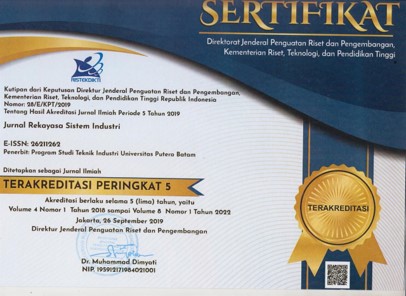INTEGRASI FMEA DALAM PENERAPAN QUALITY CONTROL CIRCLE (QCC) UNTUK PERBAIKAN KUALITAS PROSES PRODUKSI PADA MESIN TENUN RAPIER
DOI:
https://doi.org/10.33884/jrsi.v6i2.2503Keywords:
Improvement, Quality Control Circle, FMEAAbstract
PT. Pajitex is one of the textile industries that produce sarongs and continues to strive to fulfill customer desires through quality sarong products. During the sarong production process, there are still various product defects that can reduce consumer confidence in the resulting sarong products. Therefore, PT. Pajitex strives to reduce the number of defects that occur in the sarong manufacturing process by exploring various causes of defects. The purpose of this study was to analyze the defective edge on the CR3082 plate using the Quality Control Circle (QCC) method. The QCC method is a quality control system through the 8-step method with a continuous improvement system. At the defect search stage, use quality control tools such as Pareto diagrams and fishbone diagrams, and use the Failure Mode Effect Analysis (FMEA) method to obtain the highest RPN value which is a priority in the improvement proposal, and in determining the improvement proposal using the PDCA Methods. Based on the results of the analysis obtained, the cutter cutting and the needling process are not perfect and the tuck-in setting is not precise has the highest RPN value, which is equal to 120, so this activity needs to be monitored and followed up
References
Darsono. (2013). Analisis Pengendalian Kualitas Produksi Dalam Upaya Mengendalikan Tingkat Kerusakan Produk. JURNAL EKONOMI – MANAJEMEN – AKUNTANSI, 35, 1–17.
Desy, I., Hidayanto, B. C., & Astuti, H. M. (2014). Penilaian Risiko Keamanan Informasi Menggunakan Metode Failure Mode and Effects Analysis di Divisi TI PT. Bank XYZ Surabaya. Seminar Nasional Sistem Informasi Indonesia, September, 467–472.
Fachry Hafid, M., & Muh Syukur Yusuf, A. (2018). Analisis Penerapan Quality Control Circle Untuk Meminimalkan Binning Loss Pada Bagian Receiving Pt. Hadji Kalla Toyota Depo Part Logistik Makassar. Journal of Industrial Engineering Management, 3(2), 1. https://doi.org/10.33536/jiem.v3i2.228
Khamaludin, K., & Respati, A. P. (2019). Implementasi Metode QCC untuk Menurunkan Jumlah Sisa Sampel Pengujian Compound. Jurnal Optimasi Sistem Industri, 18(2), 176. https://doi.org/10.25077/josi.v18.n2.p176-185.2019
Nasution, A. Y., Yulianto, S., & Ikhsan, N. (2018). Implementasi Metode Quality Control Circle untuk Peningkatan Kapasitas Produksi Propeller Shaft di PT XYZ. Jurnal Mesin Teknologi, 12(1), 33–39. sintek: JURNAL MESIN TEKHomepage: http://jurnal.umj.ac.id/index.php/sintek
Puspitasari, N. B., & Martanto, A. (2014). Penggunaan Fmea Dalam Mengidentifikasi Resiko Kegagalan Proses Produksi Sarung Atm (Alat Tenun Mesin) (Studi Kasus Pt. Asaputex Jaya Tegal). J@Ti Undip : Jurnal Teknik Industri, 9(2), 93–98. https://doi.org/10.12777/jati.9.2.93-98
Rahayu, Y., Riyanto, A., & Ramdhani, L. S. (2020). Perlakuan Akuntansi Yang Tepat Terhadap Produk Cacat Pada Perusahaan Berdasarkan Pesanan. Jurnal Ilmiah Ilmu Ekonomi, 9(1), 1–9.
Ratnadi, & Suprianto, E. (2016). PENGENDALIAN KUALITAS PRODUKSI MENGGUNAKAN ALAT BANTU STATISTIK ( SEVEN TOOLS ) DALAM UPAYA MENEKAN TINGKAT. INDEPT, 6(2), 10–18.
Wicaksono, L. D., & Syahrullah, Y. (2020). Perbaikan Kualitas Produk Pengecoran Logam Dengan Menggunakan Metode Quality Control Circle (Qcc). Heuristic, 17(1), 29–42. https://doi.org/10.30996/he.v17i1.3569
Windarti, T. (2014). Pengendalian Kualitas Untuk Meminimasi Produk Cacat Pada Proses Produksi Besi Beton. J@Ti Undip : Jurnal Teknik Industri, 9(3), 173–180. https://doi.org/10.12777/jati.9.3.173-180
















